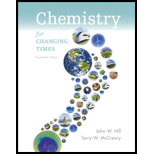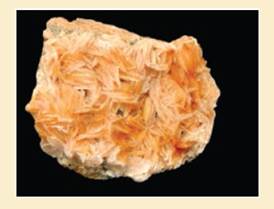
Chemistry For Changing Times (14th Edition)
14th Edition
ISBN: 9780321972026
Author: John W. Hill, Terry W. McCreary
Publisher: PEARSON
expand_more
expand_more
format_list_bulleted
Concept explainers
Textbook Question
Chapter 1, Problem 43P
In his 1739 textbook, Traite elementaire de Chimie. Antoine Lavoisier (Chapter 2) listed 33 known elements, one of which was baryte, Which of the following observations best shows that baryte cannot be an element?
a. Baryte is insoluble in water.
b. Baryte melts at 1530 °C.
c. Baryte has a density of 4.48 g/cm3.
d. Baryte is formed in hydrothermal veins and around hot springs.
e. Baryte is formed as a solid when sulfuric acid and barium hydroxide are mixed.
f. Baryte is formed as a sole product when a particular metal is burned in oxygen.

Expert Solution & Answer
Want to see the full answer?
Check out a sample textbook solution
Students have asked these similar questions
Question 15
What is the major neutral organic product for the following sequence?
1.
POCI₂
pyridine
?
2. OsO4
OH
3. NaHSO
Major Organic Product
✓ OH
OH
'OH
OH
'OH
'CI
URGENT! PLEASE HELP!
Assign theses carbons
Chapter 1 Solutions
Chemistry For Changing Times (14th Edition)
Ch. 1 - Prob. 1RQCh. 1 - Why do experiments have to be done to support a...Ch. 1 - Why can't scientific methods always be used to...Ch. 1 - How does technology differ from science?Ch. 1 - Prob. 5RQCh. 1 - Prob. 6RQCh. 1 - What is a DQ? What does a large DQ mean? Why is it...Ch. 1 - What derived units of (a) mass and (b) length are...Ch. 1 - What is the Sl-derived unit for volume? What...Ch. 1 - Prefix Symbol Definition tera- T 1012 - M - centi-...
Ch. 1 - Prob. 11RQCh. 1 - Identify the following work as either applied...Ch. 1 - Penicillin kills bacteria, thus saving the lives...Ch. 1 - Prob. 14PCh. 1 - Prob. 15PCh. 1 - X-rays are widely used in medicine and dentistry....Ch. 1 - Prob. 17PCh. 1 - The virus called HIV causes AIDS, a devastating...Ch. 1 - Which are realistic masses for a cellular...Ch. 1 - In Europe, A2 sized paper measures 594 mm 420 mm,...Ch. 1 - Which one(s) of the following are likely to be...Ch. 1 - Sample X on the moon has exactly the same mass as...Ch. 1 - Which of the following is a reasonable volume for...Ch. 1 - Which of the following is a reasonable...Ch. 1 - Earth's oceans contain 3.501 0 8 mi3 of water and...Ch. 1 - What is the area of Earth's oceans in square...Ch. 1 - Consider the two tubes shown below. The aluminum...Ch. 1 - Which one(s) of the following could be the inside...Ch. 1 - Identify the following as physical or chemical...Ch. 1 - Identify the following as physical or chemical...Ch. 1 - Identify the following changes as physical or...Ch. 1 - Identify the following changes as physical or...Ch. 1 - Identify each of the following as a substance or a...Ch. 1 - Identify each of the following as a substance or a...Ch. 1 - Which of the following mixtures are homogeneous,...Ch. 1 - Which of the following mixtures are homogeneous,...Ch. 1 - Every sample of the sugar glucose (no matter where...Ch. 1 - An advertisement for shampoo says, "Pure shampoo,...Ch. 1 - Which of the following represent elements, and...Ch. 1 - Prob. 40PCh. 1 - Prob. 41PCh. 1 - Without consulting tables, write a symbol for each...Ch. 1 - In his 1739 textbook, Traite elementaire de...Ch. 1 - In 1774 Joseph Priestley isolated a gas that he...Ch. 1 - Change the unit for each of the following...Ch. 1 - Convert each of the following measurements to the...Ch. 1 - Carry out the following conversions. a. 5.52104 mL...Ch. 1 - Carry out the following conversions. a. 546 mm to...Ch. 1 - Indicate which is the larger unit in each pair. a....Ch. 1 - There are about...Ch. 1 - Express the length of a 31 -cm ruler in (a) mm,...Ch. 1 - What is the volume in liters of (a) a 352-mL soft...Ch. 1 - (You may need data from Table 1.6 for some of...Ch. 1 - (You may need data from Table 1.6 for some of...Ch. 1 - (You may need data from Table 1.6 for some of...Ch. 1 - (You may need data from Table 1.6 for some of...Ch. 1 - (You may need data from Table 1.6 for some of...Ch. 1 - (You may need data from Table 1.6 for some of...Ch. 1 - (You may need data from Table 1.6 for some of...Ch. 1 - (You may need data from Table 1.6 for some of...Ch. 1 - Prob. 61PCh. 1 - (You may need data from Table 1.6 for some of...Ch. 1 - (You may need data from Table 1.6 for some of...Ch. 1 - (You may need data from Table 1.6 for some of...Ch. 1 - Liquid nitrogen, used for freezing sperm samples,...Ch. 1 - Normal body temperature is about 37 °C. What is...Ch. 1 - Prob. 67PCh. 1 - Prob. 68PCh. 1 - A certain chemistry class is 1.00 microcentury ( ...Ch. 1 - 70. A unit of beauty, a helen, thought to have...Ch. 1 - 71. English chemist William Henry studied the...Ch. 1 - Prob. 72APCh. 1 - Prob. 73APCh. 1 - For Problems 74 and 75t, classify each of the...Ch. 1 - For Problems 74 and 75, classify each of the...Ch. 1 - Prob. 76APCh. 1 - Prob. 77APCh. 1 - Prob. 78APCh. 1 - Prob. 79APCh. 1 - Prob. 80APCh. 1 - Prob. 81APCh. 1 - Prob. 82APCh. 1 - Prob. 83APCh. 1 - Prob. 84APCh. 1 - Prob. 85APCh. 1 - Prob. 86APCh. 1 - The density of a planet can be approximated from...Ch. 1 - The extrasolar planet HAT-P-i orbits a star 450...Ch. 1 - Prob. 89APCh. 1 - Prob. 90APCh. 1 - Prob. 91APCh. 1 - Prob. 92APCh. 1 - Prob. 1.1CTECh. 1 - Prob. 1.2CTECh. 1 - Prob. 1.3CTECh. 1 - Prob. 1.4CTECh. 1 - Prob. 1.5CTECh. 1 - Prob. 1.6CTECh. 1 - Prob. 1CGPCh. 1 - Prob. 2CGPCh. 1 - Prob. 3CGPCh. 1 - Materials Needed: • 1/4 cup dark corn syrup • 1/4...Ch. 1 - Materials Needed: • 1/4 cup dark corn syrup • 1/4...Ch. 1 - Prob. 3CHQCh. 1 - Prob. 4CHQCh. 1 - Materials Needed: • 1/4 cup dark corn syrup • 1/4...
Knowledge Booster
Learn more about
Need a deep-dive on the concept behind this application? Look no further. Learn more about this topic, chemistry and related others by exploring similar questions and additional content below.Similar questions
- Assign these protonarrow_forwardCould you please solve the first problem in this way and present it similarly but color-coded or step by step so I can understand it better? Thank you!arrow_forwardCould you please solve the first problem in this way and present it similarly but color-coded or step by step so I can understand it better? Thank you!arrow_forward
- Could you please solve the first problem in this way and present it similarly but (color-coded) and step by step so I can understand it better? Thank you! I want to see what they are doingarrow_forwardCan you please help mne with this problem. Im a visual person, so can you redraw it, potentislly color code and then as well explain it. I know im given CO2 use that to explain to me, as well as maybe give me a second example just to clarify even more with drawings (visuals) and explanations.arrow_forwardPart 1. Aqueous 0.010M AgNO 3 is slowly added to a 50-ml solution containing both carbonate [co32-] = 0.105 M and sulfate [soy] = 0.164 M anions. Given the ksp of Ag2CO3 and Ag₂ soy below. Answer the ff: Ag₂ CO3 = 2 Ag+ caq) + co} (aq) ksp = 8.10 × 10-12 Ag₂SO4 = 2Ag+(aq) + soy² (aq) ksp = 1.20 × 10-5 a) which salt will precipitate first? (b) What % of the first anion precipitated will remain in the solution. by the time the second anion starts to precipitate? (c) What is the effect of low pH (more acidic) condition on the separate of the carbonate and sulfate anions via silver precipitation? What is the effect of high pH (more basic)? Provide appropriate explanation per answerarrow_forward
- Part 4. Butanoic acid (ka= 1.52× 10-5) has a partition coefficient of 3.0 (favors benzene) when distributed bet. water and benzene. What is the formal concentration of butanoic acid in each phase when 0.10M aqueous butanoic acid is extracted w❘ 25 mL of benzene 100 mL of a) at pit 5.00 b) at pH 9.00arrow_forwardCalculate activation energy (Ea) from the following kinetic data: Temp (oC) Time (s) 23.0 180. 32.1 131 40.0 101 51.8 86.0 Group of answer choices 0.0269 kJ/mole 2610 kJ/mole 27.6 kJ/mole 0.215 kJ/mole 20.8 kJ/molearrow_forwardCalculate activation energy (Ea) from the following kinetic data: Temp (oC) Time (s) 23.0 180. 32.1 131 40.0 101 51.8 86.0 choices: 0.0269 kJ/mole 2610 kJ/mole 27.6 kJ/mole 0.215 kJ/mole 20.8 kJ/molearrow_forward
arrow_back_ios
SEE MORE QUESTIONS
arrow_forward_ios
Recommended textbooks for you
 Chemistry: Principles and ReactionsChemistryISBN:9781305079373Author:William L. Masterton, Cecile N. HurleyPublisher:Cengage Learning
Chemistry: Principles and ReactionsChemistryISBN:9781305079373Author:William L. Masterton, Cecile N. HurleyPublisher:Cengage Learning Chemistry & Chemical ReactivityChemistryISBN:9781337399074Author:John C. Kotz, Paul M. Treichel, John Townsend, David TreichelPublisher:Cengage Learning
Chemistry & Chemical ReactivityChemistryISBN:9781337399074Author:John C. Kotz, Paul M. Treichel, John Townsend, David TreichelPublisher:Cengage Learning Chemistry & Chemical ReactivityChemistryISBN:9781133949640Author:John C. Kotz, Paul M. Treichel, John Townsend, David TreichelPublisher:Cengage Learning
Chemistry & Chemical ReactivityChemistryISBN:9781133949640Author:John C. Kotz, Paul M. Treichel, John Townsend, David TreichelPublisher:Cengage Learning Chemistry: The Molecular ScienceChemistryISBN:9781285199047Author:John W. Moore, Conrad L. StanitskiPublisher:Cengage Learning
Chemistry: The Molecular ScienceChemistryISBN:9781285199047Author:John W. Moore, Conrad L. StanitskiPublisher:Cengage Learning World of Chemistry, 3rd editionChemistryISBN:9781133109655Author:Steven S. Zumdahl, Susan L. Zumdahl, Donald J. DeCostePublisher:Brooks / Cole / Cengage LearningChemistry: Matter and ChangeChemistryISBN:9780078746376Author:Dinah Zike, Laurel Dingrando, Nicholas Hainen, Cheryl WistromPublisher:Glencoe/McGraw-Hill School Pub Co
World of Chemistry, 3rd editionChemistryISBN:9781133109655Author:Steven S. Zumdahl, Susan L. Zumdahl, Donald J. DeCostePublisher:Brooks / Cole / Cengage LearningChemistry: Matter and ChangeChemistryISBN:9780078746376Author:Dinah Zike, Laurel Dingrando, Nicholas Hainen, Cheryl WistromPublisher:Glencoe/McGraw-Hill School Pub Co

Chemistry: Principles and Reactions
Chemistry
ISBN:9781305079373
Author:William L. Masterton, Cecile N. Hurley
Publisher:Cengage Learning

Chemistry & Chemical Reactivity
Chemistry
ISBN:9781337399074
Author:John C. Kotz, Paul M. Treichel, John Townsend, David Treichel
Publisher:Cengage Learning

Chemistry & Chemical Reactivity
Chemistry
ISBN:9781133949640
Author:John C. Kotz, Paul M. Treichel, John Townsend, David Treichel
Publisher:Cengage Learning

Chemistry: The Molecular Science
Chemistry
ISBN:9781285199047
Author:John W. Moore, Conrad L. Stanitski
Publisher:Cengage Learning

World of Chemistry, 3rd edition
Chemistry
ISBN:9781133109655
Author:Steven S. Zumdahl, Susan L. Zumdahl, Donald J. DeCoste
Publisher:Brooks / Cole / Cengage Learning

Chemistry: Matter and Change
Chemistry
ISBN:9780078746376
Author:Dinah Zike, Laurel Dingrando, Nicholas Hainen, Cheryl Wistrom
Publisher:Glencoe/McGraw-Hill School Pub Co
Types of Matter: Elements, Compounds and Mixtures; Author: Professor Dave Explains;https://www.youtube.com/watch?v=dggHWvFJ8Xs;License: Standard YouTube License, CC-BY